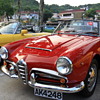Posted 10 years ago
 vetraio50
vetraio50
(756 items)
Pierre-Victor Jamaer ( Bruxelles 1825-1902) was the chief architect of the city of Brussels. His task was to integrate the look of the historic buildings of the town centre in the mid nineteenth century. He created a neo-Gothic style inspired by the ideas of the architect and theorist Eugène Viollet- le-Duc. It was much to the taste of Septimus and Clara Miller. This is an interior shot of what is known these days as la Salle Gothique (Gothic Room).
The Salle Gothique is on the first floor of the Hôtel de ville or Stadhuis. It is 195 ft. long and 81 ft. wide. It is an area used for official functions and receptions. When the Millers visited Brussels in 1907 access to the Salle Gothique was not as easy as it is today when you can do a 45 minute tour on a Wednesday or a Sunday afternoon.
Note the work on the ceilings: Jamaer's grand version of Gothic revival. These days those chandeliers have disappeared but the central row of electric lights remain.
On the walls you can see in the alcoves a series of panels that reflect the commercial past of the city of Brussels. They are not paintings, rather they are eight tapestries designed by the great Belgian painter and teacher Willem Geets (1838 - 1919) which represent the Trade Guilds of the city.
Eight tapestries woven between 1877 and 1883 by the Manufacture Braquenié & Cie.
They reflect the glorious past of the city of Brussels.
This is a bi-lingual postcard published by Th. Van den Heuvel éditeur, Bruxelles.


























Many thanks AGHCOLLECT!
You never fail to amaze!
Many thanks BLUNDERBUSS! These cards have taught me so much!
Great! I read that a long time ago tapestries were made for and used like storm windows to keep cold air out in winter! Windows were thin glass.
Many thanks AUSTRO, SEAN 'n Don!
Curtains for the windows and tapestries for the walls.
"What people tend to forget is that, in winter-time, especially in the countries which experienced exceptionally heavy snowfalls, the interior of a house or building was often not much warmer than the temperature outside! The point of tapestries was to trap heat inside a room and act like a crude form of insulation. Wherever possible, tapestries were hung to keep warm air in, and cold air out."
http://scheong.wordpress.com/2012/06/14/warmth-and-comfort-keeping-warm-throughout-history/
Your very welcome Kevin!!
Thanks again GEO, VIOLETORANGE 'n ANTIQUESINNJ too!
I have enjoyed reading all your posts Vet . These were a great find and tell a lot ! love !!
Love it! Thanks for the help you gave me with my old book. I've made a new post for you.
Doing the rounds instead of emails for a change & stumbled across this. Kev you must really have a lot of this type of post card
Many thanks FORTAPACHE, PHIL, GARY, MANIKIN, TONINO, ZOWIE, PETEY & WALKSOFTLY!
Many thanks BLUNDERBUSS, MIKELV 'n ANTIQUES IN NJ!
Many thanks POPS52!
Many thanks TOM 'n VINTAGEFRAN!
Many thanks TED STRAUB!
Many thanks ROYCROFTBOOKSFROMME!